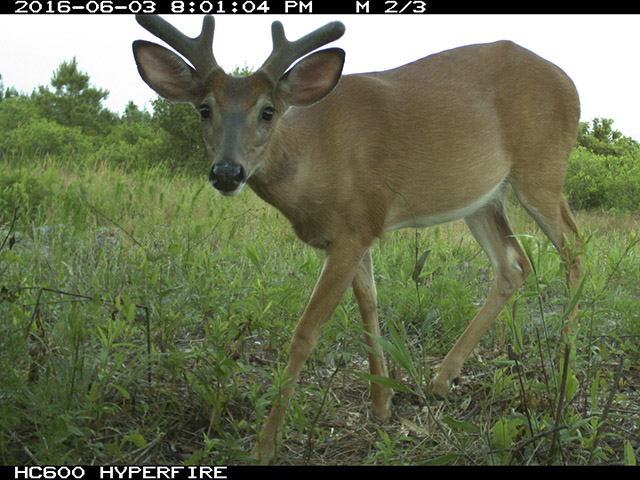N.C.’s Candid Critters: Researchers ask for public help in largest ever camera trap survey
For immediate release ‐ October 17, 2016
Contact: Roland Kays, 919.707.8250 and Jon Pishney, 919.707.8083. Images available upon request

RALEIGH, N.C. — Do you ever wonder what animals lurk in the wildest parts of the state? Or in your own backyard? Still waiting for photographic proof of a North Carolina mountain lion? (Or the Beast of Bladenboro?) Now is your chance to discover the secrets of wildlife right here in North Carolina by participating in “North Carolina’s Candid Critters,” a new research project of the N.C. Museum of Natural Sciences, N.C. Wildlife Resources Commission and N.C. State University. N.C.’s Candid Critters will be the largest camera trap survey ever, with a goal of 20-30,000 active sites over the next three years.
“This is a fun and innovative project that allows North Carolinians to discover all of the different species of animals in the back yard and across the state,” said N.C. Dept. of Natural and Cultural Resources Secretary Susan Kluttz. “I applaud N.C. Museum of Natural Sciences, N.C. Wildlife Resources Commission and N.C. State University for inspiring our citizens to participate and better understand how research can impact our knowledge.”
This citizen science project will span the entire state, from the mountains to the sea. No matter what county you live in, you can borrow a camera trap from a nearby public library to set on approved public lands. If you own your own camera trap, you can set it on either approved public land or in your own backyard. Then wait and see what critters you catch. At the same time that you are discovering what wildlife lives near you, you will be helping scientists learn more about deer reproduction and the distribution of all mammal species across the state.
According to project coordinator Arielle Parsons, research associate with the Museum of Natural Sciences’ Biodiversity Research Lab, “Before we can answer all these questions about mammals we need to collect massive amounts of data, in this case camera trap images, from across all 100 counties in North Carolina. We really need the public’s help to accomplish this. The more people that participate, the more we can learn about North Carolina’s critters.” For more information or to sign up, visit NCCandidCritters.org.
Camera traps allow scientists (and citizen scientists) to collect pictures of animals without disturbing them. These cameras can capture thousands of digital photos, which are then stored online indefinitely, allowing scientists now and in the future to look at how the state’s mammals change over time. One of the main scientific advantages of pictures from camera traps is that they are “verifiable,” which means that they are evidence that an animal was located in a specific time and place. The photos generated turn into data, allowing scientists to map where animals live and when and where they are most active across the state. They can then use this data to study how wildlife interacts with the environment, with humans and with other species. For example, Museum scientists recently used camera trap photos to determine that human recreation — like hiking, hunting and dog walking — is largely compatible with most wildlife species in the Southeast and doesn’t cause measurable disturbance.
“Tree-mounted, motion-triggered cameras are an efficient way to harmlessly collect high-quality data on mammals and their movements,” remarks Emlyn Koster, director of the North Carolina Museum of Natural Sciences. “With its mission to illuminate the interdependence of nature and humanity, and at a time when citizen involvement in scientific research is surging, camera trapping attracts students and communities to our core questions of what do we know?, how to do we know?, what is happening now? and how can I participate?.” Koster adds: “The Museum is delighted that Roland Kays, head of its Biodiversity Research Lab, is at the forefront of this new collection methodology and that he and his team are able to assist the NC Wildlife Resources Commission towards greater statewide knowledge about deer and coyote populations.”
The North Carolina Museum of Natural Sciences (11 W. Jones St. and 121 W. Jones St.) in downtown Raleigh is an active research institution that engages visitors of every age and stage of learning in the wonders of science and the natural world, drawing them into the intriguing fields of study that are critical to the future of North Carolina. Hours: Mon.- Sat., 9 a.m.-5 p.m., and Sun., noon-5 p.m. Visit the Museum online at www.naturalsciences.org. Emlyn Koster, PhD, Museum Director; Susan Kluttz, Secretary, N.C. Department of Natural and Cultural Resources; Pat McCrory, Governor.
The N.C. Department of Natural and Cultural Resources (NCDNCR) is the state agency with a vision to be the leader in using the state’s natural and cultural resources to build the social, cultural, educational and economic future of North Carolina. Led by Secretary Susan Kluttz, NCDNCR’s mission is to improve the quality of life in our state by creating opportunities to experience excellence in the arts, history, libraries and nature in North Carolina by stimulating learning, inspiring creativity, preserving the state’s history, conserving the state’s natural heritage, encouraging recreation and cultural tourism, and promoting economic development. NCDNCR includes 27 historic sites, seven history museums, two art museums, two science museums, three aquariums and Jennette’s Pier, 39 state parks and recreation areas, the N.C. Zoo, the nation’s first state-supported Symphony Orchestra, the State Library, the State Archives, the N.C. Arts Council, State Preservation Office and the Office of State Archaeology, along with the Division of Land and Water Stewardship. For more information, please call (919) 807-7300 or visit www.ncdcr.gov.

